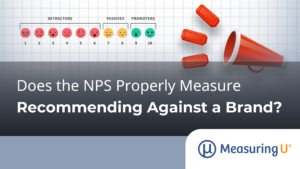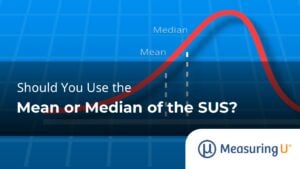Topics
Topics

How Does the UX Job Market Look for 2025?
It seems like 2024 was filled with nonstop bad news about UX job losses and difficult job searches. Layoffs in tech are nothing new. What seems to have been different in the past two years has been the volume of layoffs across so many companies and how few new jobs were posted. Having been in

47 UX Metrics, Methods, & Measurement Articles from 2024
Happy New Year from all of us at MeasuringU®! In 2024, we posted 47 articles and continued to add features to our MUiQ® UX testing platform to make it even easier to develop studies and analyze results. We hosted our 11th UX Measurement Bootcamp—a blended virtual event attended by an international group of UX practitioners

How Many People Do You Need to See Trip on Your Carpet Before Fixing It?
You invite your friends over for a gathering at your house. As the party gets started, you watch in horror as a friend trips on the edge of your carpet before she even takes the first sip of her Cabernet (now spilled on your white couch). You rush to fix the carpet. But before you

What Is a Typical No-Show Rate for Moderated Studies?
You have grand research plans. Prototype ready. Stakeholders scheduled to observe. The time comes, and the participant is a no-call no-show. No-shows are a fact of life when conducting UX research. It happens for remote and in-person research. You need to plan for no-shows. While over-recruiting makes sense, you also don’t want to over-over-recruit and

Do UX Certifications Pay Off?
What is the value of UX certification? How do you learn the methods UX professionals use? A few university programs offer courses in UX or related fields. Certainly, nothing beats hands-on experience conducting your own usability test on a prototype, running a survey, and interviewing stakeholders. But how do you demonstrate to others (employers in

User Experience Salaries & Calculator (2024)
Continuing a decades-long tradition, in 2024 we worked with the UXPA to collect and understand the UX profession’s latest compensation, skills, and composition. We hosted the survey on our MUiQ® platform and summarized the findings on salaries and related skills of UX professionals from around the world. The details for the past and current UXPA

Incorporating Clutter in the SUPR-Q Measurement Framework
Clutter distracts and detracts from a good user experience. A cluttered website makes it hard to find information. Clutter gets in the way of completing tasks. At least that’s what we think agbout clutter. But is there quantifiable evidence that a cluttered design degrades a website’s user experience? To answer that question, you need a

How Well Does the Net Promoter Score Measure Likelihood-to-Discourage?
Is not recommending the same as discouraging or recommending others to not use or purchase from a brand? While a lack of recommending seems like it would correlate with NOT recommending, we suspect there may be a difference but are unsure how much. In our previous article, we looked to the published literature and found

Confirming the Perceived Website Clutter Questionnaire (PWCQ)
Poor layout, irrelevant ads, overwhelming videos: websites can be cluttered. Clutter can lead to a poor user experience. Poor experiences repel users. So how does one measure clutter? Earlier, we did a deep dive into the literature to see how clutter has been first defined and then measured. We found the everyday concept of clutter

Does the NPS Properly Measure Recommending Against a Brand?
Is happy the opposite of sad? Is dissatisfied the opposite of satisfied? Is discourage the opposite of recommend? And is not recommending the same as recommending against? When computing the Net Promoter Score (NPS), people who rate the 0–10-point likelihood-to recommend-item high (a 9 or 10) are categorized as promoters and those who give low

Building a Website Clutter Questionnaire
Clutter, clutter everywhere, nor any questionnaire to measure. In a previous article, we described our search for a measure of perceived clutter in academic literature and web posts, but we were left unquenched. We found that the everyday conception of clutter includes two components that suggest different decluttering strategies: the extent to which needed objects

Should You Use the Mean or Median of the SUS?
Since its development in the 1980s, System Usability Scale (SUS) score analysis has focused on estimating and comparing means. The mean is one type of average. Would it be more appropriate to estimate and compare SUS medians instead of means? To investigate this question, we analyzed and compared SUS means and medians collected from over